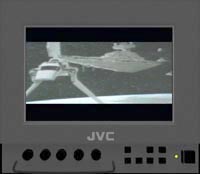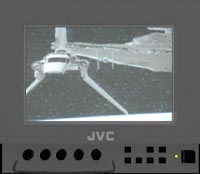

| Widescreen | Pan & Scan | |
|---|---|---|
 |
 |
|
| also known as: | also known as: | |
| Letterboxed | Fullscreen |
| An aspect ratio is the relationship between the width and the height of
a screen image. Virtually all sound films until 1953 were at a ration of 1.37:1, which is to
say, slightly wider than they were tall - a modest rectangle. Since the television ratio is
1.33:1, very little is lost when an older film is shown on television. (Even films shot in
the later standard ratio of 1.66:1 don't suffer too badly when viewed on a television.)
In the 1950s, however, Hollywood's attempt to lure people away from their television sets and back into theaters led to a battle of screen sizes, beginning with CinemaScope, which was more than twice as wide as it was high at a ratio of 2.35:1. Today, most films are shot and shown in a ratio of 1.85:1; since this has become the "standard," such films are no longer thought of as "widescreen." Below you will see the range of screen ratios along with which processes use them. |
||
| 2:1 | Metroscope, Natural Vision, Grandeur, Panascope, Realife, Superscope, Vitascope, Vista Vision | |
|---|---|---|
| 2.2:1 | Dimension 150, Panavision Super 70, Superpanorama, Super Panavision 70, Super Technirama 70, Todd-AO | |
| 2.35:1 | Agascope, Arriscope, ArriVision, Cinepanoramic, CinemaScope, CinemaScope 55, Cinescope, Cromoscope, Daiescope, Duo-Vision, Dyaliscope, Euroscope, Franscope, Grandscope, Hammerscope, J-D-C Scope, Megascope, Naturama, Nikkatsu Scope, Panavision, Panoramic, Regalscope, RKO-Scope, Scanoscope, Shawscope, Sovscope, Space-Vision, Spectrascope, Superama, SuperCinescope, Superscope 235, Super Techniscope, Super 35, SuperTotalscope, System 35, Technirama, Techniscope, Technovision, Todd-AO 35, Toeiscope, Tohoscope, Totalscope, Totalvision, Ultrascope, Vistarama, Vistascope, WarnerScope, Warwickscope | |
| 2.4:1 | Panavision | |
| 2.75:1 | MGM Camera 65, Ultra Panavision 70 | |
| 2.8:1 | Cinerama | |